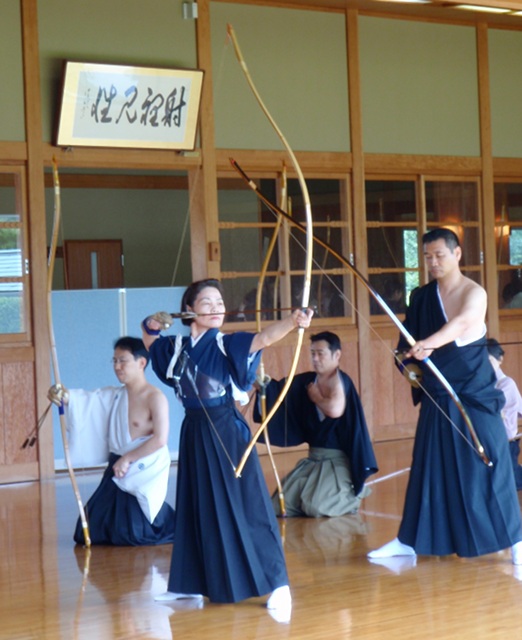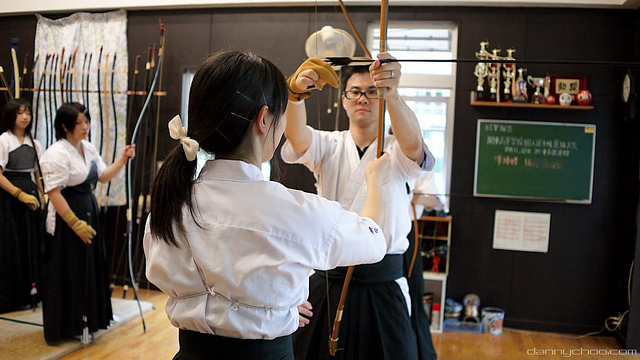Kyudo

Arrows for use in kyudo. At one time arrows were tipped with hawk or eagle feathers, but the rarity of these birds means that swan or turkey feathers are now used instead.
Japanese martial arts are famous throughout the world, especially karate and judo, but Japan is home to many other martial traditions that are less well-known, and one of them is kyudo. Literally meaning the ‘way of the bow’, the roots of kyudo lie in ancient Shinto tradition, which has ritualized the use of bows and arrows for over 2,000 years.
For much of Japanese history, archery was considered to be the most important skill of the samurai, more important than the swordsmanship with which they are nowadays more closely associated. The importance of bows and arrows in Japanese warfare began to decline after the Portuguese introduced matchlock rifles to Japan in 1543. With the bow losing its place as a weapon of war, it increasingly took on a ceremonial role, leading ultimately to the highly ritualized form of archery that is kyudo.
For most practitioners, kyudo is an art and not a sport, and an archer’s attitude and dignity are often considered more important than actually hitting the target. A kyudo practitioner advances to the shooting place with slow and graceful movements, and lifts the bow above his or her head. They then draw back the string as they lower the bow until the arrow becomes level with their cheek. Finally, they release the arrow and let it fly towards the target. During this whole process, they focus completely, never once taking their eyes off the target. A sign of a good archer is that their concentration is so great that an aura of calmness and serenity seems to envelop them.
Arrows are always shot in pairs, first a ‘male’ arrow that spins clockwise, and then a ‘female’ arrow that spins in the opposite direction. The target is small (usually 36 centimetres in diameter), and is placed 28 metres from the shooting place, so even hitting it is a big challenge. When an arrow does hit the target, everyone shouts ‘sha’ in unison, a call that literally means ‘arrow’ or ‘shot’. In competitions, scores are based on how many arrows hit the target, not on how centrally they are placed.

A woman taking part in a kyudo grading exercise. The men kneeling in the background are waiting for their turn, while the man to her left will release the second of his two arrows once she has taken her shot.
Many Japanese high schools have kyudo clubs, so it’s not uncommon to see school students carrying around the giant bows used in kyudo. Even the shortest bows that are used by people less than 1.5 metres tall are well over 2 metres long when unstrung. Kyudo can be quite a dangerous activity, as the arrow may clip the face, or the bowstring can spring back on the arm, so it’s rarely taught to children under the age of 15.
Kyudo practitioners almost always dress in hakama, a form of kimono, which for men often leaves their left nipple exposed. Women wear a breastplate to protect themselves from injury, and both men and women wear stiff deerskin gloves to protect their hands. People new to kyudo may spend the first few months of training stretching a rubber bow to build up strength, and practicing the motions of drawing the bow and taking aim, before they ever get to shoot their first arrow.
Like with many other martial arts, practitioners can gain ranks, or ‘dan’ based on their proficiency, but some people reject any form of grading or competition on principle, preferring to focus on the goal of personal development. Even when archers do take part in grading, they don’t wear the coloured belts or symbols of rank worn by practitioners of other martial arts.
Both arrows and bows are usually made of bamboo, according to a centuries old design (although nowadays it is possible to buy carbon fibre bows and aluminium arrows). It is important to treat bows with respect, so it is very rude to step over a bow placed on the ground, and you must never touch another person’s bow without their permission.

Kyudo at Yashio High School in Tokyo. Here we see a female student teaching a visitor to the school how to use a bow. Despite its martial origins, kyudo seems to be at least as popular with girls as with boys.
Kyudo is supposed to develop the character of its practitioners, not only in relation to archery itself, but also in how they conduct themselves in daily life. The idea is that immersing yourself totally in the task at hand can clear the mind, and so be a form of ‘meditation through action’ (a concept borrowed from Zen Buddhism). This will help your natural human dignity shine through the obstacles that are hiding it, leading to moral and spiritual advancement.
Perhaps surprisingly for a martial art, one of the key benefits attributed to kyudo is that it helps its practitioners to avoid conflict and to refrain from aggression. A kyudo practitioner is expected to show courtesy, compassion and morality at all times, and should be able to maintain composure and grace even when under pressure.
The principles of kyudo are sometimes summarised as ‘truth, goodness and beauty’, where truth relates to shooting with a pure mind, goodness to a person’s character, and beauty to gracefulness and the refined etiquette of kyudo. For some practitioners, kyudo comes close to being a religious observance, while for others it’s much more about skill and target practice, but it’s the philosophical and ritual elements that really distinguish kyudo from other forms of archery.
The Self Defence Force Urban Fishing
